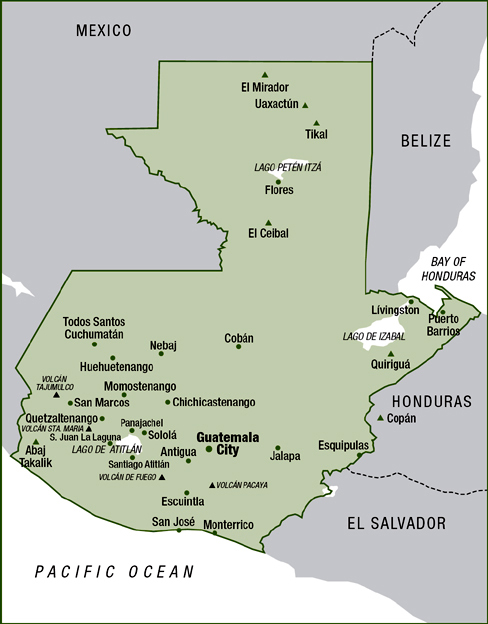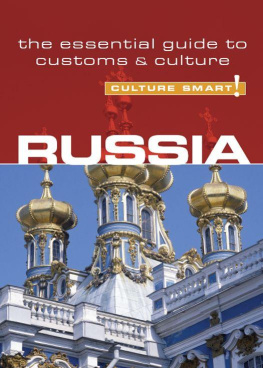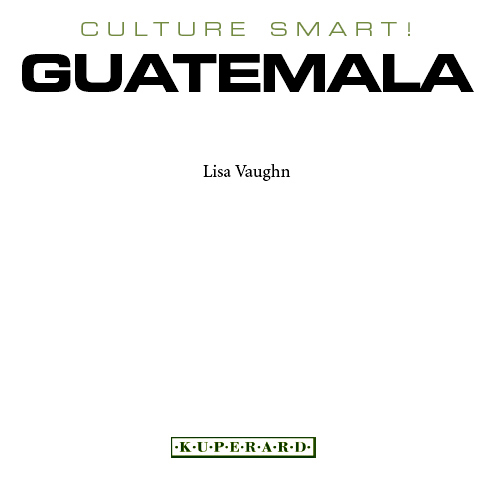eISBN: 978-1-85733-582-8
British Library Cataloguing in Publication Data
A CIP catalogue entry for this book is available from the British Library
Copyright 2007 Kuperard
Revised 2008; third printing 2010
All rights reserved. No part of this publication may be reprinted or reproduced, stored in a retrieval system, or transmitted in any form or by any means without prior permission in writing from the publishers.
Culture Smart! is a registered trademark of Bravo Ltd
First published in Great Britain 2007
by Kuperard, an imprint of Bravo Ltd
59 Hutton Grove, London N12 8DS
Tel: +44 (0) 20 8446 2440 Fax: +44 (0) 20 8446 2441
www.culturesmart.co.uk
Inquiries:
Series Editor Geoffrey Chesler
Cover image: Boats on the shore of Lake Atitln. Corbis
Images by permission of the author
Images by permission of INGUAT
v3.1
About the Author
LISA VAUGHN is an American social psychologist. While gaining her Ph.D. from the University of Cincinnati, she trained in group interaction and relationships, organizational development, teacher-learning processes, and womens studies. Applying these disciplines to cultural studiesespecially with Latino populationsshe developed and led university study abroad programs to Guatemala from 2001 to 2005. She has lived and traveled in Guatemala for extended periods over the last six years, and has adopted a Guatemalan Mayan son. She is currently Associate Professor of Pediatrics at University of Cincinnati College of Medicine.
The Culture Smart! series is continuing to expand. For further information and latest titles visit www.culturesmartguides.com
The publishers would like to thank CultureSmart!Consulting for its help in researching and developing the concept for this series.
CultureSmart!Consulting creates tailor-made seminars and consultancy programs to meet a wide range of corporate, public-sector, and individual needs. Whether delivering courses on multicultural team building in the USA, preparing Chinese engineers for a posting in Europe, training call-center staff in India, or raising the awareness of police forces to the needs of diverse ethnic communities, it provides essential, practical, and powerful skills worldwide to an increasingly international workforce.
For details, visit www.culturesmartconsulting.com
CultureSmart!Consulting and CultureSmart! guides have both contributed to and featured regularly in the weekly travel program Fast Track on BBC World TV.
contents
Map of Guatemala

introduction
The largest and most populous of the Central American countries, Guatemala is famously a land of contrasts and contradictions. It has great physical beauty, with ancient Mayan ruins, volcanoes, lakes, and rain forests, and a conglomeration of diverse peoples and cultures held together by fierce national pride and love for a country they want to improve.
Guatemala is unique in Central America in that more than half its population is of Mayan Indian origin. Today it is a combination of ancient Mayan heritage, Spanish colonialism, and Western influences, mainly from the United States. There has been an increase in tourism since the 1996 peace accords between the government and leftist insurgents ended a brutal thirty-six-year civil war.
Although the Maya may appear to be quiet and submissive, their colorful costumes, markets, and fiestas tell a different story. Most think of themselves as indgenas first and Guatemalans second, and are committed to safeguarding their Mayan identity, traditions, and customs.
In addition to the Mayan and Ladino peoples, there are two small ethnic groups, the Xinca and the Garfuna. Each group has its own cultural, social, linguistic, and economic characteristics.
Despite their horrific history and frequent disappointment in their governments, the Guatemalans remain hopeful for a better life. They are a vibrant and resilient people, sustained by their strong family relationships, who are committed to staying positive and looking ahead. Visitors will find them welcoming and friendly.
Culture Smart! Guatemala provides an introduction to the complexities of Guatemalan society. It shows how history has shaped the values and attitudes of today. It describes different aspects of Guatemalan life, including home, family, religion, festivals, typical food, and business practice. It offers key insights into the mind-set of the people, and practical advice on how best to behave in different situations and avoid cultural misunderstandings.
For a rewarding and enjoyable visit to Guatemala, forget your schedule and allow yourself to go with the flow of chicken buses and long conversations in the streets. Be prepared to meet and talk to Guatemalans from all ethnic groups and imbibe their rich culture. The more you immerse yourself in the country and the people, the more you will be enchanted. You will want to return, over and over again!
Key Facts
| Official Name | Repblica de Guatemala (Republic of Guatemala) |
| Capital City | Ciudad de Guatemala (Guatemala City) | Population approx. 4 million |
| Major Cities | Guatemala City, Quetzaltenango, Antigua, Chichicastenango, Puerto Barrios, Escuintla |
| Area | 42,042 sq. miles (108,890 sq. km) | About the size of Tennessee |
| Terrain | Mostly mountainous with narrow coastal plains and rolling limestone plateau | Mountains include volcanoes, some of which are active |
| Climate | Tropical; hot and humid in the lowlands; cooler in the highlands |
| Currency | Quetzal (Q) which divides into 100 centavos; named after the national bird, the quetzal | 1 U.S. dollar = Q 7.6 1 Euro = Q 9.6 |
| Population | 12,728,111 (2007 estimate) |
| Ethnic Makeup | Ladino and European, c. 40%; Mayan, c. 60%; Indigenous non-Mayan, 0.2%; other, 0.1% |
| Language | Spanish 60%; Amerindian languages 40% | 23 officially recognized Amerindian languages |
| Religion | Roman Catholic; Protestant; indigenous Mayan beliefs |
| Government | Constitutional democratic republic with an elected president serving a four-year term | Unicameral Congress of the Republic. The president is both chief of state and head of government. |
| Media | The main TV channel is Canal 3. More than 300 cable operators, plus several evangelical channels Several commercial and government-owned radio stations, plus evangelical stations | Main newspapers include PrensaLibre, elPeridico, Siglo Veintiuno, and La Hora; popularpress includes Al Da and NuestroDiario |
|





